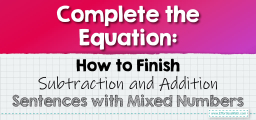How to Do Scaling by Fractions and Mixed Numbers?
Welcome to this article where we will dive into the exciting world of scaling by fractions and mixed numbers.

Scaling is an essential mathematical concept that helps us to adjust the size of a given quantity while maintaining its proportionality.
Whether you are a beginner or an advanced learner, this article will provide you with a clear and concise guide to scaling by fractions and mixed numbers.
A step-by-step guide to scaling by fractions and mixed numbers
There are some scaling rules:
- Whenever you multiply a fraction by a number smaller than \(1\) whole, its size gets scaled down.
- Whenever you multiply a fraction by a number larger than \(1\) whole, its size gets scaled up.
Scaling by fractions and mixed numbers can be done in just a few simple steps. Here is a step-by-step guide to help you master this skill:
Step 1: Understand the Problem: Read the problem carefully to determine what needs to be scaled and by what amount. This will help you choose the appropriate fraction or mixed number to use in the scaling process.
Step 2: Write the Original Quantity: Write down the original quantity that needs to be scaled. This will help you keep track of the starting point as you perform the scaling operation.
Step 3: Write the Fraction or Mixed Number: Write down the fraction or mixed number that you will use to scale the original quantity. This will be the amount by which you want to increase or decrease the original quantity.
Step 4: Convert Mixed Numbers to Improper Fractions If you are using a mixed number, convert it to an improper fraction. To do this, multiply the whole number by the denominator of the fraction, and add the numerator. Write the result over the denominator to get the improper fraction.
Step 5: Multiply or Divide To scale by a fraction, multiply the original quantity by the fraction. To scale by a mixed number, multiply the original quantity by the mixed number’s improper fraction. If you are scaling down, divide the original quantity by the fraction or mixed number.
Step 6: Simplify the Result (if necessary): If the result is an improper fraction, simplify it by reducing it to its lowest terms. If the result is a mixed number, convert it back to a mixed number if necessary.
Step 7: Write the Final Answer: Write down the final answer, including the units of measurement if applicable. Make sure to label the answer appropriately to avoid confusion.
Here’s an example to help illustrate these steps:
Example: You have a recipe that calls for \(\frac{3}{4}\) cups of flour, but you need to make a double batch. How much flour will you need?
Step 1: Understand the Problem: We need to scale the original quantity of flour by a factor of \(2\).
Step 2: Write the Original Quantity: The original quantity is \(\frac{3}{4}\) cup of flour.
Step 3: Write the Fraction: We need to scale by a factor of \(2\), so we will use the fraction \(\frac{2}{1}\).
Step 4: Convert Mixed Numbers to Improper Fractions Not applicable in this example.
Step 5: Multiply or Divide To scale by the fraction, we multiply the original quantity by the fraction: \(\frac{3}{4} \times \frac{2}{1} = \frac{6}{4}\)
Step 6: Simplify the Resul:t The result is an improper fraction, so we simplify it to its lowest terms: \(\frac{6}{4} = \frac{3}{2}\)
Step 7: Write the Final Answer: The final answer is \(\frac{3}{2}\) cup of flour. We can also express this as \(1\frac{1}{2}\) cups of flour.
Scaling by Fractions and Mixed Numbers – Example 1
Which expression is greater or least? \(2×5 \frac{2}{3} …. 11\)
Solution:
Step 1: Calculate: \(2×5 \frac{2}{3}=2×\frac{17}{3}=\frac{34}{3}=10 \frac{4}{3}\).
Step 2: Compare them. \(10 \frac{4}{3}\) is less than \(11\). So, \(2×5 \frac{2}{3}<11\)
Scaling by Fractions and Mixed Numbers – Example 2
Which expression is greater or least? \(3×4 \frac{3}{4} …. 13\)
Solution:
Step 1: Calculate: \(3×4 \frac{3}{4}=3×\frac{19}{4}=\frac{57}{4}=14 \frac{1}{4}\)
Step 2: Compare them. \(14 \frac{1}{4}\) is greater than \(13\). So, \(3×4 \frac{3}{4}>13\)
Exercises for Scaling by Fractions and Mixed Numbers
Compare each expression.
- \(\color{blue}{6\times 3\frac{10}{7}………15}\)
- \(\color{blue}{4\times 2\frac{3}{7}……… 12}\)
- \(\color{blue}{3\times 4\frac{5}{9}……… 13}\)

- \(\color{blue}{6\times 3\frac{10}{7}\:>15}\)
- \(\color{blue}{4\times 2\frac{3}{7}<12}\)
- \(\color{blue}{3\times 4\frac{5}{9}>13}\)
Related to This Article
More math articles
- FREE 4th Grade FSA Math Practice Test
- FREE 6th Grade MEAP Math Practice Test
- How to Solve Word Problems of Dividing Big Numbers
- 5 Best CHSPE Math Study Guides
- Top 5 Free Websites for OAR Math Preparation
- 5th Grade TCAP Math Worksheets: FREE & Printable
- Trigonometric Integrals: A Thorough Guide On Everything You Need To Know
- How to Find Least Common Multiple? (+FREE Worksheet!)
- Completing the Puzzle: How to Finishing Equations when Multiplying Fractions by Whole Numbers Using Models
- Overview of the TASC Mathematics Test


























What people say about "How to Do Scaling by Fractions and Mixed Numbers? - Effortless Math: We Help Students Learn to LOVE Mathematics"?
No one replied yet.